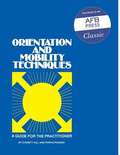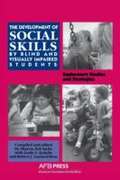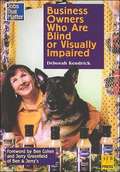Special Collections
American Foundation for the Blind
Description: American Foundation for the BlindPress offers a wide range of information for students, professionals, researchers, and blind and visually impaired people and their families. #teachers #disability
- Table View
- List View
An Introduction to Working with the Aging Person Who Is Visually Handicapped (2nd edition)
by Dava GraysonThis book deals with aged blind persons, the ways and means of lending them a helping hand, services available to them, and solving other problems.
Living with Impaired Vision
by Anne Yeadon and Dava GraysonBlind and visually impaired people: active, concerned about their jobs, their families, their communities, obtaining a good education, discovering interesting ways to use their leisure time, and above all, as different from one another as any other group of people who happen to have one characteristic in common. Today there are visually impaired people in every major area of employment from professional occupations to technical and clerical work. There are blind lawyers and college professors and insurance salesmen and social workers, blind typists and switchboard operators, auto mechanics and chemical engineers.
Prescriptions for Independence
by Nora Griffin-Shirley and Gerda GroffPrescriptions for Independence: Working with Older People Who Are Visually Impaired has been designed to provide comprehensive information in a clear and readable way so that visually impaired people, their friends and families, and those who work with them have simple suggestions within easy reach. Readers will find that most people who are visually impaired do have usable vision and do not require special assistance, but they will also find what they need to know about common forms of visual impairment and adaptations and information that are useful to some visually impaired people in daily life.
Piagetian Reasoning and the Blind
by Yvette HatwellThe book reports the results of a series of studies undertaken in the early 1960s on the cognitive development of children with congenital blindness.
Program Planning and Evaluation for Blind and Visually Impaired Students
by Kathleen Mary Huebner and Jack HazekampThe guidelines have been developed as a resource for parents, staff, and administrators in identifying and assessing the unique needs of visually impaired students and planning, providing, evaluating, and improving the quality and cost-effectiveness of programs serving these students.
Orientation and Mobility Techniques
by Purvis Ponder and Everett W. HillA large-format manual covering definitions, techniques, and devices, designed for administrators, educators, rehabilitation counselors, and other professionals concerned with the mobility training process. A classic compilation of information on an essential subject.
The Profession of Orientation and Mobility in the 1980s
by Mark M. Uslan and Everett W. Hill and Alec F. PeckThis book is a report of two national studies to compile descriptive statistical information about the demographic trends that will influence the future of the O&M profession--one conducted in 1983 and the other in 1985.
Hand in Hand
by Elga Joffee and Jeanne Glidden Prickett and Kathleen Mary Huebner and Therese Rafalowski WelchThis series was designed to develop resources for educators of children who are visually impaired, hearing impaired, and severely disabled. The Hand In Hand materials emphasize the communication and mobility skills crucial to independence, and provide important information to help service providers do their jobs effectively. Containing contributions from more than 30 nationally recognized experts in the field of deaf-blindness, this groundbreaking information consists of four components that can be used separately or together. A two-volume, self-study text that explains how deaf-blind students learn, focusing on essential communication and mobility skills. Designed to provide comprehensive information in an easy-to-read way, this invaluable resource includes identified key concepts, self-study questions and answers, and references. The user-friendly format includes concise "Help at a Glance" and "From Theory to Practice" sections throughout. Sidebars, figures, tables, graphs, and photos offer additional perspectives and information.
The Effects of Blindness and Other Impairments on Early Development
by Zofja S. JastrazembskaA scientific study of blind children, where there are frequently marked delays in locomotor achievements by sighted standards.
Ability Structure and Loss of Vision
by Jyrki JuurmaaPsychological testing of the ability structures of the blind and sighted was commenced almost simultaneously during the first decades of this century. However, a majority of the studies concerning the blind, and the most crucial among them, sought to develop IQ-type test batteries, intended mainly for appraising their school achievement. By contrast, systematic studies have not been carried out to explore the relationships among different, mutually relatively independent traits and the quantitative contributions of such traits to different test performances. This lack of interest is perhaps due to the narrow range of occupations regarded as suitable for the blind: there has been no acute need for a more differentiated picture.
HIV/AIDS Prevention
by Judy Matsuoka and Christine E. Pawelski. and Gaylen KappermanThis manual is designed to help rehabilitation teachers, educators, and other practitioners who work with blind and visually impaired persons provide their clients with the facts they need to deal with the issues concerning HIV/AIDS.
Perceptual Factors in Braille Word Recognition
by Carson Y. Nolan and Cleves J. KederisThis monograph presents the findings of several years of study of the braille system as a communication process.
The Development of Social Skills by Blind and Visually Impaired Students
by Sharon Zell Sacks and Linda S. Kekelis and Robert J. Gaylord-RossThe book, using an ethnographic approach, outlines the theoretical background of social-skills development, presents case studies and suggests guidelines for helping Blind and Visually Impaired children shape those encounters into satisfying ones.
Recreation Programming for Visually Impaired Children and Youth
by Jerry D. KelleyThe book is designed primarily for the recreation consultant or trainer concerned with assisting the community recreation leader in his or her efforts to provide recreation programs and services for the visually impaired child.
Business Owners Who Are Blind or Visually Impaired
by Deborah KendrickThe second title in the exciting Jobs That Matter series written by an award-winning blind journalist, Business Owners Who Are Blind or Visually Impaired demonstrates the wide range of careers and talents that can be pursued by persons with visual impairments. Each profile features a successful individual who has accomplished his or her dream of business ownership and who shares important insights. From a lawyer and an accountant to a florist and a gourmet cook, the range of engaging stories told will inspire young adults with visual impairments and the parents, teachers, and counselors who advise them.
The Community of the Blind
by Yoon Hough KimDr. Kim has investigated the validity of the widely-held view that while there are a large number of blind persons whose social lives are centered in the mainstream, that is with sighted persons, there are an equally large number of blind persons whose social lives are restricted mainly to other blind persons.
Data on Blindness and Visual Impairment in the U. S.
by Corinne KirchnerData from a wide variety of sources cover age, gender, race and ethnicity, education, employment and income, service delivery systems, vision services, employment-related services, and income benefits program.
Looking at Employment Through a Lifespan Telescope
by Corinne Kirchner and Emilie Schmeidler and Alexander TodorovThis book gathers representative survey data from the legally blind population on employment issues, and analyzes it using a lifespan perspective (considering age, career stage, and age-at-onset of visual impairment), which is critical to understanding widely different employment issues for subgroups of the blind and visually impaired population.
The Conquest of Blindness
by Henry Randolph LatimerThe term "Conquest of Blindness" is taken to include any preventive, remedial, educational, rehabilitating, or relief phase of work pertaining to the handicap of blindness.
The primary aim of the volume is to lift work for the conquest of blindness out of the miasma of alms and asylums into the more wholesome atmosphere of social adjustment.
Other aims of the volume are to serve as a supplementary text for the use of the profession, and as an incentive to the chance reader to delve more deeply into the subject, and to present as modestly as may be the autobiography of one blind person who has contributed in small measure toward the conquest of blindness.
What of the Blind? A Survey of the Development and Scope of Present-Day Work with the Blind
by Helga LendeWhat of the Blind? is designed with a view to presenting in one single volume the experience and opinions of leaders in this specialized field. The material has been grouped so that the student may easily find the aspect of the subject in which he is especially interested. Following each chapter is a short reading list which will serve as a guide to further study.
What of the Blind? A Survey of the Development and Scope of Present-Day Work with the Blind
by Helga LendeThis book is intended as a companion volume to What of the Blind? Recently published by the American Foundation for the Blind. The first volume was brought out in answer to a long-felt need for a convenient reference work to put in the hands of professional workers, board members and lay persons desiring general information on work with the blind. The subjects treated were mainly of a general nature as will be seen from the table of contents appended to this book.
Art Not by Eye
by Yasha LisencoThe book, in two parts, deal with avenues for adventitiously blind adult, and the blind and severely visually impaired adults in the art program.
Berthold Lowenfeld on Blindness and Blind People
by Berthold LowenfeldThis book contains articles spanning a period of almost 40 years by Dr. Berthold Lowenfeld, a creative writer in education of the visually handicapped on Blindness and Blind People.
The Blind Preschool Child
by Berthold LowenfeldThis book is a collection of papers presented at the National Conference On The Blind Preschool Child on March 13-15, 1947.
The Social Sources of Adjustment to Blindness
by Irving Faber Lukoff and Martin WhitemanThe impact of society on the blind is a complex issue, and many different tacks are necessary even if we are to only make little headway through the eddies and currents that alter and modify people's lives. This study is focused on the social forces that influence the adaptation of blind persons. The information derives from almost 500 interviews with blind persons selected from all walks of life.



